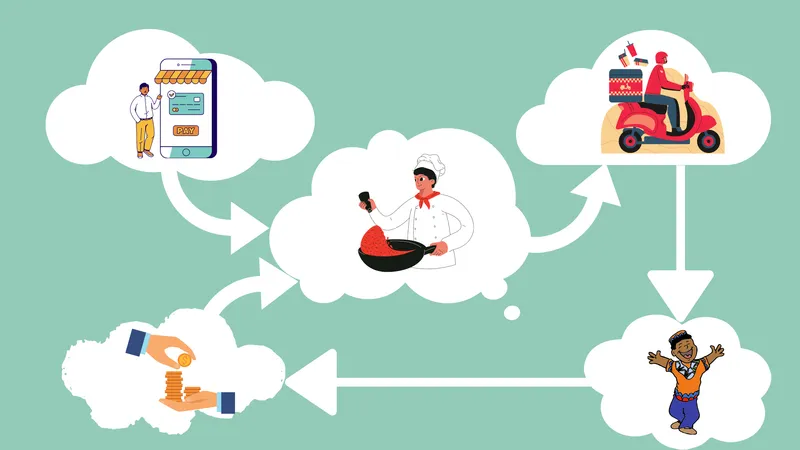Disrupting the consumption landscape: Key tech trends in the F&B industry
Contactless, hygiene-focused, quick, and convenient services are in demand more than ever before. This has led to the rise of several tech-driven options for businesses to adopt and evolve.
It is said that change is the only constant, and, in the post-COVID world, change has also been the only option. Every industry adapted to the rapid transformation necessitated by the pandemic, and many business processes were rendered almost unrecognisable, almost overnight. The singular upside of this upheaval was the acceleration of tech adoption across industries.
Consumer-facing industries were the most effected by the pandemic, with the F&B segment bearing a significant brunt. Restaurants, cafés, bars, and street stalls—all of them witnessed footfalls dropping to almost nil during the lockdown.
The only choice was to evolve with the times, and this is where technology came into the picture. Tech tools allowed business owners to stay connected with their consumers, meet their demands, and ensure business continuity.
A recent report by Research and Markets says that the Indian food tech sector would expand at a CAGR of 39% between 2021 and 2025 and reach Rs 1,868 billion by 2025.
Against this backdrop, here is a look at a few tech trends that are dominating the F&B space.
Vending machines
With technology in the picture, vending machines are no longer just slot machines that accept cash and reward you with snacks. With tech like IoT and AI, they have evolved into smart, sophisticated machines that can take online orders, accept cashless payments, and heat food on the spot.
Vending machines can also be used to store home-cooked meals and healthy food that are perishable. Seeing the growing health consciousness among consumers, especially after the COVID outbreak, healthy food options significantly increase the customer base for vending machines.

New-age vending machines are placed in premium locations like office spaces, hotel lobbies, hospitals, and universities to allow people access to high quality food within their proximity. Technologically advanced vending machines can predict demand for particular products and prompt brands to replenish the stock.
This considerably bolsters customer experience and directly benefits brands that utilise vending machines as outlets to sell their products.
Mobility vending
A revolution in the F&B industry, mobility vending has enabled brands to place vending machines in cabs, buses, and trains to simplify access to food for consumers in transit. Powered entirely by IoT and smart mobility technology, these strategically placed kiosks offer contactless access to food.
Such kiosks also offer cashless payment options, app-based ordering systems, and a hygienic experience for consumers. Not only do on-the-go snacking options benefit F&B brands and consumers, but they also offer an additional revenue stream to cab drivers and fleet owners.
Springboard for home chefs
The lockdowns following the COVID-19 outbreak led several individuals to hone their skills while at home. Several home chefs not only gave time to their craft but they also became small business owners in their own right. In this case, technology acted as a springboard that helped them streamline processes and earn revenues from their endeavours.

Tech platforms simplified order-taking, purchasing supplies, enabling online payments, facilitating deliveries, and even marketing their business. On the flip side, customers looking for home-cooked meals could pre-order, schedule deliveries, get multiple payment options, add reviews for home chefs, and track orders through the same platforms. This has significantly strengthened the home chef ecosystem in India.
Cloud kitchens
Several mainstream food brands and platforms such as Zomato, Swiggy, Biryani by Kilo, and Prasuma, have introduced cloud kitchens. Research by RedSeer states that the cloud kitchen market in India is set to reach $2 billion by 2024, indicating a massive rise in both acceptance and deployment.
Essentially, cloud kitchens facilitate online food ordering without dine-in options. In such a scenario, food service companies do not have to rent restaurant spaces to serve customers and can invest more in quality offerings and customer experience. With low operational costs, cloud kitchens can encourage entrepreneurship in the country and give consumers access to economical food options.

Wrapping up
The post-COVID era has presented new challenges to businesses in the F&B space—in the form of changing consumer preferences. Contactless, hygiene-focused, quick, and convenient services in demand more than ever before. Fortunately, this period has also offered several tech-driven options for businesses to adopt and evolve. In the F&B sector, the future is already here. Businesses that adopt these forward-looking technologies can prepare themselves for hypergrowth on the horizon.
(The author is the co-founder of Daalchini Technologies, a retail tech startup.)
Edited by Swetha Kannan
(Disclaimer: The views and opinions expressed in this article are those of the author and do not necessarily reflect the views of YourStory.)








